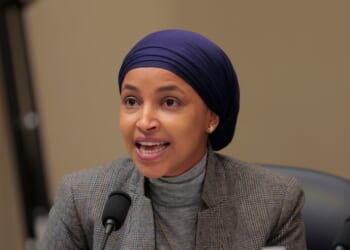As New Yorkers head to the polls on Tuesday, they don’t need anyone to tell them why they should vote for Assemblyman Zohran Mamdani, the Democratic nominee, or for Curtis Sliwa, the Republican. Each man has his loyal and fervent supporters. But voters have mostly heard a negative case for the third major candidate, former Gov. Andrew Cuomo, running independently. The message is: vote for Cuomo because he’s less terrible than Mamdani, and because Sliwa will never win, giving Mamdani the victory anyway.
Cuomo has his problems, and we don’t need to hear about them one final time. No matter whom they choose, however, voters deserve a fair chance to consider the positive case for Andrew Cuomo. So here it is.
First, in an increasingly Left-wing city, Cuomo is the proven progressive option. That’s not a positive or a negative statement — it’s just a neutral fact. If you like higher taxes on the rich, Cuomo is your guy: during his final months as governor, he raised the rate on millionaire earners by nearly a full percentage point, to just under 10 percent. He also created two new, even higher tax brackets on personal income above $5 million, and a higher business-tax rate, all raising about $4.3 billion annually. Even earlier, he significantly boosted the minimum wage.
The obvious riposte here is that Cuomo didn’t want to hike taxes. Worried about a future primary challenge, he caved to pressure from progressive lawmakers, whose power was growing during President Trump’s first term. True enough, but an elected official being responsive to political pressure isn’t necessarily a bad thing, from many liberal New Yorkers’ perspective. Cuomo, if elected mayor, isn’t going to govern as some sort of crypto-conservative or even moderate autocrat. He will have to deal with the liberal and progressive City Council and the liberal and progressive state legislature.
After a close election, a Mayor Cuomo would presumably be concerned about another future challenge from the Left, and would accordingly maintain and enact progressive policies to head off that challenge.
A Left voter might reasonably think, “If I want a progressive, I’ll just vote for Mamdani.” But the more moderate among them might consider that checks and balances in a democracy are good. Cuomo failed to counteract the state legislature on several issues, from the tax hike to the details of eliminating and reducing cash bail. But at least he tried. When it comes to negotiating budgets with the council or tax policy with the state legislature, a Mayor Mamdani wouldn’t even try.
Cuomo’s well-known political flexibility isn’t a bad thing, if the result of that flexibility is to give voters a real choice when it matters. Cuomo is explicitly running against Mamdani’s proposed $9 billion annual tax hikes on New York City’s wealthy earners and corporations now. “You keep taxing businesses and wealthy people in New York City, there will be nobody left,” he told Fox News earlier in October.
Yes, that’s an exaggeration — except the city (and state) are losing their fair share of millionaires, with the share of American millionaire earners in New York City falling to 4.2% in 2022, down from 6.5% to and 2010, according to the Citizens Budget Commission, echoing the analyst E.J. McMahon’s earlier research.
Voters without the ability to create a perfectly consistent mayor from scratch must ask themselves: are they going to punish Cuomo for being wrong back then, even if he is right, right now, and even if it means punishing themselves? Cuomo may have no strong ideological impulse either to raise or lower taxes, but, whether out of real conviction or political expediency, he is providing a critical contrast to Mamdani now, in saying that now is not the time for another increase.
Moreover, voters attracted to Mamdani because they want New York City to be more affordable should realize one big difference between Mamdani’s plans and Cuomo’s: Cuomo’s experience makes him a natural pragmatist, which makes it more likely that his affordability initiatives would succeed.
To wit: Cuomo would target his affordability plans to poorer people and people on the lower end of the middle class, whereas Mamdani would offer his subsidies to everybody. That’s an important distinction, because Gotham has finite funds; benefits that go to everyone, by definition, are benefits that can’t go to the people who most need them. For instance, Mamdani would make city buses free for everyone, whereas Cuomo would target families earning under $48,000 a year for free-transit subsidies, including subway subsidies. Similarly, Cuomo would increase benefits to lower-income New Yorkers to purchase food, whereas Mamdani would open five city-run grocery stores to cut food prices for everyone.
There are flaws in Cuomo’s affordability plans, sure. But in a choice between two transit plans — one that offers targeted subsidies and doesn’t favor only one type of transit, and one that offers a massive new universal entitlement but only on one type of mass transit — the latter is the more flawed. Similarly, in a choice between two grocery plans, Cuomo’s is superior because targeted to those who need help the most.
Further, a big piece of New York’s affordability problem is education and childcare. One fact that came across in the two general-election debates in October is that Mamdani isn’t interested in K-12 education; it’s just not one of his issues. He’s so uninterested in the topic, in fact, that he’d even give up mayoral control of the 900,000-student school system. Cuomo, on the other hand, has a straightforward and implementable plan for parents trying to get their kids into a rigorous school in the higher grades: double the number of schools for which an entrance exam is required to meet the high demand.
“An elected official being responsive to political pressure isn’t necessarily a bad thing.”
As for childcare: Mamdani’s marquee plan for “no-cost” universal care, beginning with babies 5 weeks old, is perfect because it is nonexistent. He offers no timeline and no hint of how this would work: babies aren’t 4-year-olds. Would parents have to commit to sending infants and toddlers to “school” five days a week, for example, as pre-K works, or would they have emergency drop-off and part-time and nighttime options?
Cuomo, by contrast, commits to expanding guaranteed pre-K to 3-year-olds, which is where it makes sense to start, as it’s easier. On early childcare, he shows an interest, saying he’d “pioneer [a] new model to co-locate early childhood development services in public schools.” But he doesn’t promise too much — which is a good thing in the context of an idea that is both expensive and logistically hard, because of the higher ratio of adult minders to babies and toddlers required.
On criminal justice, Cuomo is most vulnerable to voters inclined to vote for Sliwa. After all, he is the governor who signed into law leniency on bail, discovery laws, and juvenile crimes. Despite tweaks by his successor, Gov. Kathy Hochul, over the past four years, this leniency continues to contribute to New York’s persistently higher crime rate, post-2020.
Again, though, the relevant question isn’t what he did then, but where we go from here. Voters can consider a key difference between Cuomo and Mamdani. Cuomo has, if rather belatedly, repudiated the city’s unworkable plan to close the jails on Rikers Island by 2027 and rebuild four much smaller jails in four of the city’s five boroughs. To replace the close-Rikers plan, Cuomo says that he would gradually rebuild new jails at Rikers and provide better transportation for family members to visit the island. Mamdani, instead, only repeats the empty vow that he’ll do everything “in my power” to close Rikers within two years.
This distinction is critical, because it will determine the Big Apple’s ability to cut crime by incapacitating criminal suspects. The close-Rikers plan is unworkable in part because the four-borough jail plan would cap inmate capacity at just above half the current population, about 7,373. This abrupt decrease in capacity would require the release of thousands of violent suspects.
Moreover, Cuomo’s recent criminal-justice legacy may work in the city’s favor: as mayor, he would be under intense centrist and conservative pressure to accelerate the modest crime declines that the Eric Adams administration has achieved.
Mamdani, conversely, would face no such pressure from his own base. He predicates the ability of his new “department of community safety” to cut crime and disorder on “creating economic stability” and ensuring “that no New Yorker falls through the cracks of our social safety net.” Crime, then, wouldn’t be evidence of policing failures, but of Mamdani’s inability, constrained by the state government’s control of much of the city’s budget, to implement socialist policies fully. No matter how bad things get under Mamdani’s vision of public safety, he can’t be accountable — because full democratic socialism has never been tried. Or something.
One final issue looms: personality. Many people look at Andrew Cuomo and feel repulsion at the shape-shifting and other defects, fearing the lack of a core. Maybe so. But Mamdani, too, is showing the same capacity to shape-shift. Just five years ago, Mamdani wanted to defund the police; he has now fully denounced that position. Mamdani says that he’d like to retain Jessica Tisch, Adams’s appointee, as police commissioner, without explaining how he’d square her proactive approach to policing, including toward disturbed people in the subways, with his preferred reliance on social-service civilians.
Mamdani is not without his own personality flaws: a good anti-capitalist socialist really shouldn’t own investment property in a poor country (in Mamdani’s case, Uganda).
Sliwa’s potential voters, on the other hand, are rightly comfortable with his personality. The Guardian Angels co-founder and longtime civic activist has demonstrated a remarkable consistency in his professional values and goals over several decades.
But Sliwa also lacks part of what New Yorkers want from Mamdani, and could partially get from Cuomo: a nuanced, if last-minute, focus on affordability. And yes, Sliwa, a Republican in a Democratic town, is simply unlikely to win, unless all polls are wildly off. Though New Yorkers who prize pure principle over practicality and pragmatism should stick to their vote, in a race that may be closer than voters think, they are indeed helping to split the more centrist and conservative vote against one socialist candidate.
As it enters its final day, this race is between a man who has probably already made most of his mistakes and revealed his flaws — and one about to begin making and revealing his own.

















